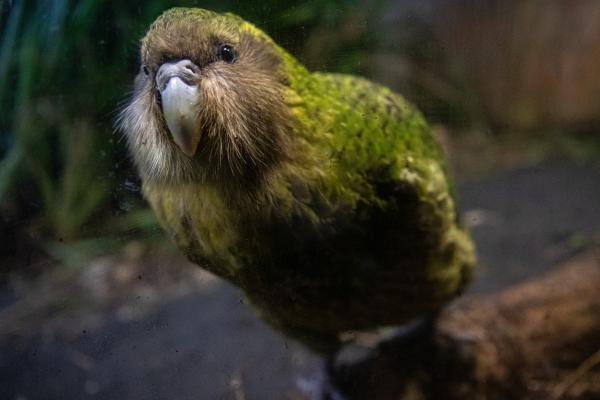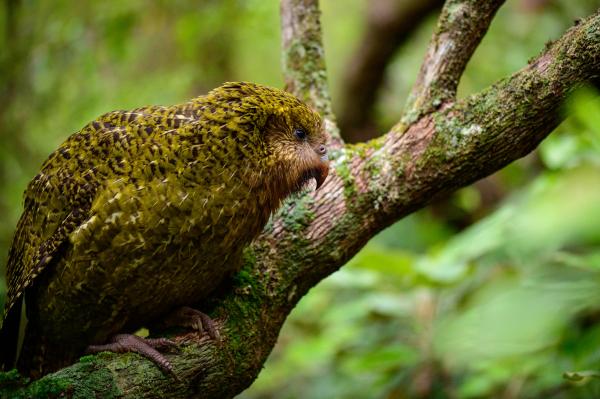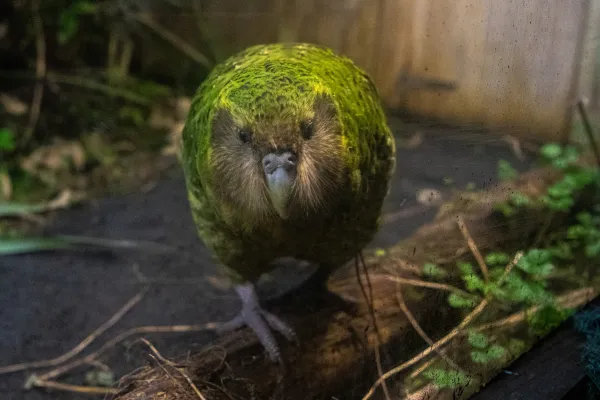The kakapo (Strigops habroptila, also known as the "owl parrot" or "night parrot" in Māori) is one of the world’s rarest and most unique birds, endemic to New Zealand. It is the only flightless and nocturnal parrot in existence and ranks among the largest parrots in the world. The kakapo is famous for its moss-green plumage, owl-like facial disc, acute sense of smell, and distinctive reproductive behaviors. Let’s take a closer look at the kakapo’s characteristics, distribution, diet, reproduction, threats, and conservation efforts.

Kakapos are large and robust parrots. Adult males can reach up to 60 centimeters in length and weigh between 3 and 4 kilograms, making them the heaviest parrots alive. Though they have wings, kakapos cannot fly; instead, their short wings are used for balance and to help them glide down from heights. Their moss-green and black-spotted plumage provides excellent camouflage among New Zealand’s native forests. The kakapo’s round, feathered face resembles that of an owl, which is how it gets its name. Its powerful beak is adapted to efficiently crush plant material. Kakapos have a keen sense of smell and exude a unique, floral or musty scent, which helps them communicate but can also attract predators.
Historically, kakapos were widely distributed across both the North and South Islands of New Zealand, inhabiting a variety of environments including subalpine shrublands, coastal forests, and broadleaf woodlands. However, due to human settlement and the introduction of invasive species, the kakapo’s range has been drastically reduced. Today, wild kakapos exist only on a few predator-free offshore islands such as Whenua Hou (Codfish Island), Anchor Island, and Little Barrier Island. These sanctuaries are critical for their survival.

Kakapos are strictly herbivorous, feeding on a wide variety of native plants. Their diet includes fruits, seeds, pollen, buds, leaves, bark, roots, rhizomes, and bulbs. The kakapo’s diet varies by season, and its strong beak and dexterous tongue allow it to process a range of plant materials efficiently.
The kakapo has a highly unusual breeding system known as “lek” mating. During the breeding season, males travel to hilltops or ridges and dig shallow bowls in the ground, which amplify the booming calls they use to attract females. Females visit these display sites and select mates based on their performance. Kakapos breed infrequently—sometimes only once every few years, or even a decade—with each clutch usually containing just one to four eggs. Their extremely low reproductive rate makes population recovery very slow. In recent years, scientists have supported kakapo breeding through supplementary feeding, artificial insemination, and intensive nest monitoring to increase hatching success.

Originally, kakapos evolved in an environment with no mammalian predators. However, habitat destruction, hunting, and the introduction of animals such as rats, cats, dogs, and stoats have devastated their numbers. Once numbering in the thousands, the kakapo population fell to just a handful of individuals. According to the IUCN Red List, the kakapo is classified as “Critically Endangered,” with only a small population remaining.
New Zealand has implemented intensive conservation actions to protect the kakapo, including relocating all surviving birds to predator-free islands, using advanced tracking systems, protecting and managing breeding sites, and maximizing genetic diversity. Each kakapo is fitted with a transmitter to monitor its movements, health, and reproductive status. Artificial insemination and genetic management are also crucial to the long-term survival of the species.
Despite being flightless, kakapos are skilled climbers and can ascend to the tops of tall trees. They use their wings to parachute down gently. Their deep, resonant booming calls can carry for several kilometers at night. When threatened, kakapos rely on their camouflage and remain motionless, a strategy that worked well against extinct native raptors but fails against introduced mammalian predators. Kakapos also have remarkable longevity, with individuals living up to 60 years or more.

The kakapo is not only an ecological icon of New Zealand but also a symbol of the global struggle to save critically endangered species. Its recovery depends on rigorous scientific management, ongoing monitoring, and public support. With continued conservation efforts, there is hope that kakapo numbers will rise and that more people worldwide will come to appreciate and protect this “night parrot.”
References
IUCN Red List. 2018. https://www.iucnredlist.org/species/22685245/129751169
Bibliography
Thomasy, H. 2021. Creating a high-tech island to save one of the world's rarest birds. Mongabay. https://es.mongabay.com/2021/03/creando-una-isla-de-alta-tecnologia-para-salvar-a-una-de-las-aves-mas-raras-del-mundo/
Department of Conservation Te Papa Atawbai. https://www.doc.govt.nz/nature/native-animals/birds/birds-a-z/kakapo/
Elliott, G.P. 2013 [updated 2025]. Kakapo | In Miskelly, C.M. (ed.) New Zealand Birds Online. www.nzbirdsonline.org.nz
animal tags: Kakapo
We created this article in conjunction with AI technology, then made sure it was fact-checked and edited by a Animals Top editor.